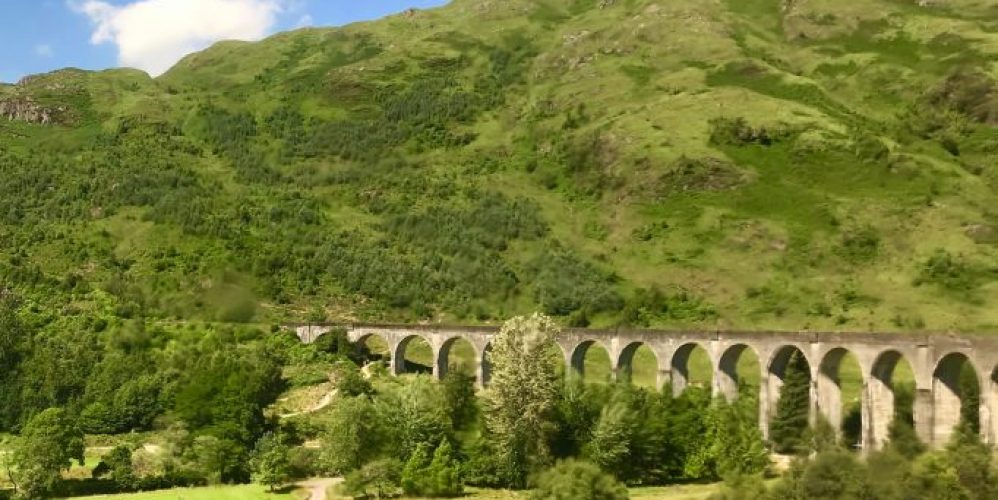Travelling by public transport often leads to surprises when using unfamiliar routes. The bus ride from Amsterdam Central to Port IJmuiden seems to pass a historic site that has been on my list of places to visit for ages: Ruigoord. A squatted stronghold with an artistic attitude somewhere between hippie visions and punk ideals. Once an island with a beautiful little church, now a haven of art and other mind-expanding activities.
Thanks to Google Maps, you always know where you are. I can follow the exact bus or train route. My little blue ball approaches the artists’ colony. Its characteristic church tower suddenly appears behind the trees. I can skip Ruigoord from my bucket list.
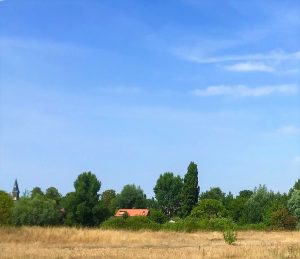
In Port IJmuiden it is not clear where the passengers should check in. Customs-officers do their work in the back of the building, on the right side of the entrance is a counter. An arrowed sign that points to the ladies behind the desks says: ‘Pets only’. People walk desperately in all kinds of directions. Married couples split, the first schisms become visible even before our holiday has even started. Passengers who had passed the customs have to return to the counters.
Our cabin is on the front side of the boat, so that we can see the direction in which we sail through the porthole. The weather is beautiful; the sun is shining and there is hardly any wind; ideal conditions for our passage.

A picture on the forward deck of the ship tells us that we might encounter dolphins and whales, plus all kinds of seabirds. That does not happen. We see a beautiful sunset in the Northeast, the direction in which we are sailing. Ships to other destinations pass by and we see slowly rotating windmills that are set up in complete parks.
According to a highly exaggerated recommendation on the table, our chef has sailed the oceans for 60 years and he has made a careful selection from a great many international kitchens that he visited in his rich life, so that the passengers have the privilege to taste culinary highlights of many different cultures on Earth.
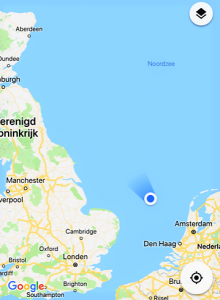
It remains light for a long time, at least until eleven o’clock. In the nightly hours I see a number of oil platforms that illuminate the North Sea spectacularly.
The bus is waiting for us and takes us rather quickly to Newcastle. Hadrian’s Wall starts in this area. We visit an ancient cathedral in the city; if you sit down here you know that you have really arrived in the United Kingdom.
The blue skies on our way to Edinburgh are unScottish, the sea is beautiful; lots of grass and trees are green thanks to the rain that has fallen here every now and then. Seascapes and beaches are followed by moorlands, hills and then a spectacular ride across the Royal Border Bridge. The Scottish border is a little further to the North. ‘Long ago the Scots and the English battled against each other severely here,’ an elderly fellow passenger tells us.
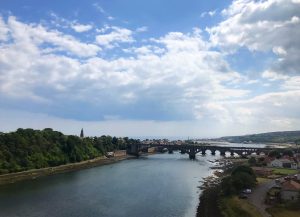
Edinburgh opens up as a crowded, full and hot city like I have never experienced before. The first time it rained, the second time it was fairly gloomy as well, but now the sun shines exuberantly. Street musicians are playing along the many terraces. I notice that pedestrian traffic lights remain red for a rediculously long time, while the traffic gets the chance to race on and on, but most people cross the streets without looking at the red lights at all.
The sun-drenched city makes us so euphoric that we board the Ferris wheel, which is quite an experience. We are almost as high as the famous Sir Walter Scott monument (1771-1832, author of ‘Ivanhoe’). A rock band with a bagpipe player as frontman gives a contemporary twist to good old Scottish traditions.

The next day is less sunny. No real rain, but a drizzle and many shades of grey. The National Gallery presents a beautiful exhibition of Rembrandt’s work from a British perspective. Rembrandt has not only painted British buildings, we also see little known work like as an alternative reading woman, a windmill in a landscape that inspired many other artists and beautiful etchings and selfies, a genre that the Dutch painter introduced.
The castle is overshadowed by a large stage and a grandstand. Later that day, the singing ladies of Bananarama will make their appearance here. We visit a shop filled with Harry Potter paraphernalia. The old part of the city is very touristlike. We walk into a church that has an exhibition about the Reformation. We talk to a certain Richard and we have an interesting conversation about the Reformation and about the Church in all its manifestations.

Later that afternoon we visit the Gallery of Modern Art, where we end up on an empty first floor, and finally descend to the basement, where a modest photo exhibition can be seen.
The last morning in Edinburgh we activate our train tickets, and walk to the National Gallery of Modern Art. According to our travel guide this should be a walk of 15 minutes, in reality it lasts half an hour, and if you wait for all the red lights at least three quarters of an hour. Beautiful work by artists whose names start with an M: Matisse, Margritte, Mondrian and Miro. The two double shots of cappuccino are very welcome at the end of our stay.
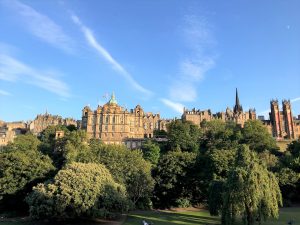
We return by bus and to our surprise we pass the National Portrait Gallery. We quickly get off and we see many Scottish portraits, old and new paintings, photographs and an exhibition about airplanes and trains from a hundred years ago.
The journey to Glasgow is much shorter than I had expected. The walk to Kelvingrove Art Gallery (the most beautiful collection of British art) is rather disappointing. The museum closes at five. At 4.40 PM we run up the stairs and the doorman asks if we want to see anything specific. ‘The Dutch masters’ I scream and off we go. Beautiful works, but no Rembrandt. French art is displayed in the adjoining hall. I walk downstairs to ask for the Rembrandt, but it has been lent out. It might very well be in Edinburgh at the Rembrandt exhibition that we have seen.

We have dinner at Life, a cozy hub that serves not only vegetarian, but even vegan dishes. At the end of the evening a singer-songwriter entertains the audience from a small stage. This is a real night out, with lots of revealing dresses and hard-laughing men. The large number of women who go out in small groups is remarkable. The street between the bar restaurant and our hotel has been closed off, because of a fire in the Art School.
We dive into the Hardrock café the next morning. The local attraction is a Amy McDonald’s jacket and ACDC’s Angus Young’s guitar. We continue our walk to the Modern Art Gallery.
The journey from Glasgow to Oban is a long one. At least three hours. But it is a nice trip. The landscape becomes more and more mountainous. We approach Oban via a detour and the train halts next to the ferry to Mull.
The town is far more lively than I’d expected. It has a good bookstore that equals the one we have seen in Glasgow. Fish and chips is the most popular dish here. You can collect it in boxes which many people do. Some even eat it on the streets. A service is going on in the local church. A handful of people attend, a choir sings, there are readings and a liturgy. When I walk out, I am approached by a man who asks me whether I am the minister; I’m the only one here who wears a suit jacket.
From the castle, near Oban, we have a nice view over the islands and the town. We have tea and a scone at the house of the MacDougal Clan. The walk to McCaig’s Tower, the pompous Colloseum imitation that was built by a rich resident of the village, is not as far as it seems. Fake or not; this is an impressive monument and we have a glorious view over the bay, where the sun leaves us in a rather dramatic way.

In Rannoch are no shops, no restaurants, no telephone coverage and no internet, not even radio, nor television. ‘The perfect way to escape the hustle and bustle of everyday life.’ In the train we see children looking at their screens uninterested in the high mountains that we pass. The Wi-Fi signal has almost disappeared. Fortunately, Google Maps still works.
The landscape becomes more and more empty. We are, however, annoyingly followed by a motorway and by electricity poles, but we will be glad if there is electricity in the hotel. The train manager predicts that Scott, the owner of the hotel is already waiting for us, which he does. Scott is a friendly person and he carries one of our suitcases. Scott takes us to his residence where he kindly welcomes us with a pot of tea. When it is time for dinner Scott leads us, as a real host, to a table in a glass room where we enjoy our food, surrounded by the majestic landscape.
After a walk of more than an hour, the next morning, we end up quite high in the mountains. On top of it we discover an orange-white stone circle, a possible announcement of the expected Lunar Eclipse two days later. The views are overwhelming here. At this height my phone suddenly receives WhatssApp messages again.
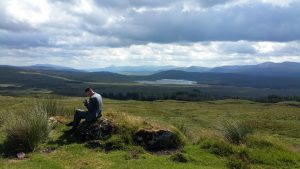
The trip to Fort William is not long. The city is built at the foot of Ben Nevis, the highest mountain in the United Kingdom. The sun burns in my neck when we walk to the hotel. The Glen Nevis walking track begins at this spot.
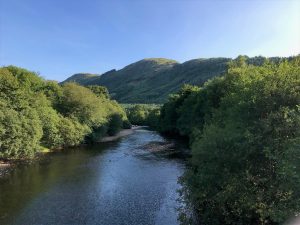
Across the river is a bridge to the starting point of the ascent of the mountain, which is only possible on foot. We see people climbing the slopes like ants. This would have been an eight-hours walk that you have to prepare very well. Seeing the gigantic, 1300 meter high mountain is impressive enough for us.
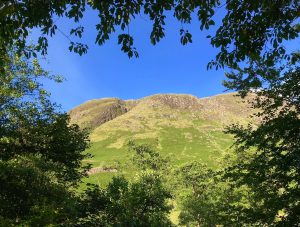
Our travel guide tells us that St. Andrews’ Church is the largest church in Scotland but that must be a mistake. It might be the largest neo-Gothic church, though. It’s a beautiful church indeed. We walk to to the water where remnants can be seen of the fort that William of Orange built which gave this city its name.
The announcer at the station apologizes for the fact that there are not four but only two train compartments available to Malleigh.
It is very crowded in the train. I sit down on the floor until we have almost reached the Glenfinnan viaduct. The train manager warns us to be ready for making pictures of the Harry Potter-bridge (from the Philosopher’s Stone film). People rush to the windows. A Japanese backpacker pushes his rucksack into my face.

Despite the delay, we are just in time for the boat that will take us to the Isle of Skye within three quarters of an hour. No single cloud in the air and that seems to be very special here. Portree on Skye is a friendly little town; many tourists shuffle through the streets. The local shops are overcrowded. The rest of the island is pretty deserted. We make a bus tour, which is better than a group tour, and we get off in a village that actually turns out to consist of about five houses. We don’t see any walking paths, so we simply walk on the highway. The rain starts to fall exactly at this moment. We visit the Dinosaurus museum mainly in the hope of being able to visit a toilet that is not available. The ‘90 meters high waterfall’, is a disappointing little stream that primarily stimulates my needs. Two hitchhikers try to get a lift in vain (the times have really changed). When the bus arrives, they decide to hop on as well. The return journey is beautiful and dry; we see Thor’s Thumb, where many people stop (their cars) to or not to ascend the mountain.

Saucy Mary’s café is the last spot we see on Skye. The train to Inverness is ready and people try to get in. The Scottish train managers doesn’t like that: the chairs have to be tagged first. When I put my suitcase on a table to find my plugs and cables the manager reprimands me immediately. It is a stunning but long journey. The landscape with its meandering rivers between the Highlands is enchanting. Dramatic cloudy skies in many shades of grey and occasional spots of blue. Finally, a waterfall that is far more impressive than the one we saw the day before. Yet it is difficult not to be distracted by a couple with a child and a single mother giving her baby a toy phone that produces penetrating sounds (I would have preferred a screaming child). My admiration for the man on the other side of the corridor increases: he has two music plugs deep in his ears and he reads The Times imperturbably from page one to the very end. Without looking out of the window once.
Hotel Royal in Inverness, next to the station, has a royal allure. Modern paintings are displayed in the lobby so that more art can be seen in the hotel than in the Art Gallery. The local Art Gallery exhibits photographs of a man on a horse who has traveled from South America to New York. For an authentic effect a bale of hay has been left behind in the room. The Art Gallery is difficult to find, because it has moved without leaving a clear route.
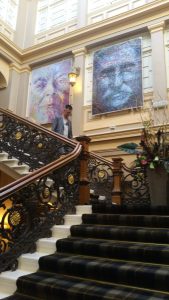
From the castle we can overlook the city and the river. We feel a little fooled when we suddenly discover a man with a fishing rod in the middle of the river, the water reaching to his knees. The Ness seems to be that shallow. Is this because of the extreme little rainfall?
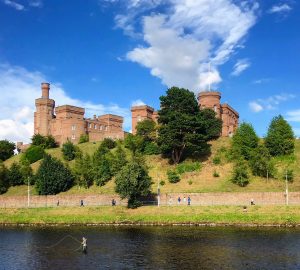
We see many people walking with blue-white flags. In a restaurant I ask what this means. The waitress tells me that it is Independence Day. Everywhere in Scotland? The girl doesn’t know. Back in the hotel we find the answer: 13,000 people have marched for Scottish independence in Inverness this day.
After the longest trip of this holiday: the five-hour ride from Inverness back to Newcastle (for the real diehards: the train drives on to London), we board our ferry again.
Just before we our departure a rainbow appears over the North Sea.
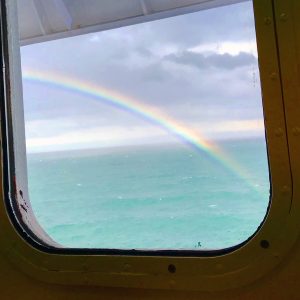
Epilogue
People from the United Kingdom who travel by boat to Amsterdam for a short visit (and return the same evening) prepare themselves for this day. What can you do between 11 AM and 3 PM? I hear people opting for a trip through the canals, others are looking for a good restaurant. When we have reached our destination in Amsterdam, the bus driver announces: ‘Ladies and gentlemans. I will pick you up at the central stadium between 15 and 16 hours. I wish you a pleasant day.’ How this story ends? That remains a mystery.





